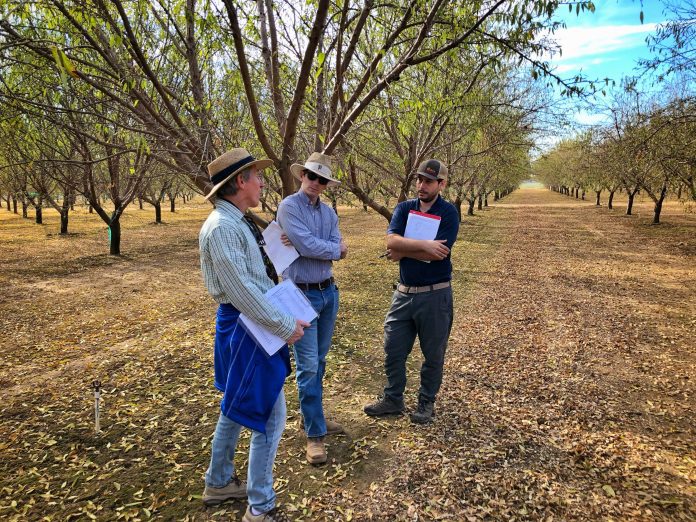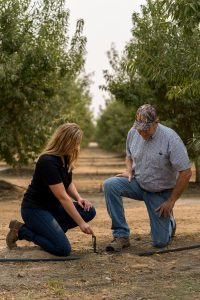
After more than 10 years, the Almond Board of California has overhauled the California Almond Sustainability Program (CASP), driven by a changing production environment and industry needs.
The overall includes a more streamlined platform as well as a new name and a new logo. “The relaunched ‘California Almond Stewardship Platform’ (still CASP) highlights the importance of leveraging research, education, self-assessment and tools to meet the needs of today’s market environment,” said Gabriele Ludwig, director of sustainability and environmental affairs for ABC. The word “platform” is used to clarify that CASP self-assessments are not the sustainability program for California almonds. Rather, it is a way for individual growers to measure their operation against industry norms, Ludwig said.
The re-envisioning of stewardship for California almonds included acknowledging that the stewardship efforts were more than the self-assessment program, Ludwig said. Rather, the California Almond Stewardship builds on the research funded by ABC, its outreach programs and the tools included along with the self-assessment tool. Also, Ludwig said, the Almond Board focused on simplifying the effort for producers to self-assess in the revamped platform, which ABC is calling CASP 2.0, while seeking to expand its benefits.
Streamlined Platform
The changes, installed last November, were driven by the ABC’s Board of Directors, which asked staff to try and improve CASP, according to Tom Devol, ABC’s senior manager of field outreach and education.
“The Board came to us last year and raised the challenge to us to revisit CASP and re-envision it,” Devol said. “And it was good timing because the staff was already looking at that challenge of how we could streamline it and what we could do to improve CASP.”
First launched in 2009, the self-assessment tool had grown over the years in both its focus and size, Devol said. “And the needs of the industry have changed since the self-assessment program was first envisioned close to 15 years ago,” he said.
“It has grown into more than just a self-assessment,” he said. “It is really based in research that we do around production practices. The research really drives a lot of the education. Then we have the self-assessment as well as tools like the nitrogen calculator and the irrigation calculator.
“So, it was a good time to kind of reframe that this is not a program, which we used to call it. It is actually a platform,” he said.
Also, Devol said, the self-assessment had grown in complexity to the point where it took a grower six to eight hours to input data on production practices.
“After 12 years, it has put on a little weight,” Devol said. “And it became kind of daunting to do for growers. We were at over 600 questions. So, we put it on a diet, and we trimmed it down. We dropped almost 40% of the questions. It has gone from a six- to eight-hour process to complete the assessment on an orchard to about two to three hours.”
“We got rid of duplicate questions, and we asked, ‘Is this question really pertinent to stewardship?’” Ludwig said.
Devol added that prior to the changes, he and other field representatives were regularly fielding questions from growers about how to answer questions in CASP. Since, he said, not so much.
“We have received very few calls,” Devol said. “It is amazing how many people have opened it, first-time people, and have had no problems or issues understanding how to complete the assessment.”

Promoting Stewardship
CASP, according to Ludwig, is just one part of the Almond Board of California’s ongoing effort to promote good stewardship production practices.
“Stewardship is nothing new to the industry,” Ludwig said. “Trying to find better ways of doing things is something we have been doing, at least from the research side, for 50 years now.
“Basically, the self-assessment questions are based on research over the years as to what practices encourage the use of inputs wisely,” she said. “We added some tools like the nitrogen calculator or the irrigation calculator to try to make it easier to for a grower to determine what level of input was appropriate for the grower’s specific situation.
“And we are actually getting quite a lot of people to engage,” she said, noting that 50% of the almond acreage in California has been assessed in CASP since 2009. Ideally, a grower would re-assess his or her operation at least every three years, she said.
CASP remains confidential, Devol said, meaning only the person who inputs the data can access the information. But the aggregate data is invaluable.
For example, he said, the online self-assessment now provides a mechanism for growers to identify their handlers, and the handlers can get aggregate, anonymous data on their growers, data that is helping handlers answer questions from buyers about how California almonds are grown. Thus, ABC has benchmarked the CASP self-assessment questions with an international program called FSA-SAI, which provides a generic list of questions around sustainability for farming. Ludwig explained that the benchmarking essentially translates the almond-specific practices into a more global language, which makes it easier for handlers to meet programs or address questions from large food companies and some retailers.
Capitalizing on the Data
Handlers, in fact, are a large part of why participation in CASP has increased dramatically over the last year, Ludwig said. Devol noted that the amount of activity in CASP over the past year was similar to the amount of activity of the previous 10 years combined.
“Handlers are encouraging their growers to participate (in CASP) because it helps them tell the story better to their buyers,” Ludwig said.
Another example of how the aggregate data can be used is to see strengths and opportunities, Devol said. “Our growers understand that when they put data in, they are the only ones who can see it,” he said. “But if I can get a better understanding of practices being used, it is helpful for me. It helps the field outreach staff understand where we need to drive education.
“The data is pretty powerful from the standpoint of understanding what is happening in the industry and where we need to engage growers,” Devol said.
Ludwig added that the aggregate information available in CASP helps the industry piggyback on the health message that almonds have benefited from greatly over the years with the fact almonds are grown sustainably.
“The consumers who care about eating healthy also care about sustainability,” she said. “If we cannot demonstrate that almonds are grown thoughtfully with good stewardship, then we can lose that credibility in the health space.”
ABC also leverages information available in the platform for reputational management, Ludwig said.
“A classic example would be when we got hit with the drought shaming, we were able to go into the CASP data at the time and say, ‘Look, 80% of the growers are using microirrigation systems,’ which is a much higher rate than on average across farming,” she said. “So, we had data. I remember the California Department of Food and Agriculture came out with a query, and we were the only ones to supply them data. And they were really pleased.”
Research Priorities
ABC also utilizes CASP data to help determine research and messaging priorities, Ludwig said.
“An example of that is in the irrigation space,” she said. “After the first five years, we did a review of the data, and at the time, a lot of growers were not using the crop coefficient to figure out how much water to apply. So, we reached out to farm advisors and asked them to explain how to do so in outreach events.”
Also, Ludwig said, when she saw how complicated it was to calculate the amount of water to apply, she encouraged researchers to devise an online irrigation calculator to help with all the steps involved. ABC now makes that available to growers.
CASP data also have been used by researchers seeking information on the rate of adoption of a particular practice, Devol said, which can help university researchers determine their priorities or ask themselves why the practice they developed is not being widely adopted.
The platform also can be leveraged by growers who wish to obtain Bee Friendly Farming certification, Devol said, in that it will alert growers who are close to meeting the standards.
At its most basic, however, CASP remains a self-assessment tool for growers who wish to document almond stewardship and, maybe, take the time to reflect on efforts they are making in their operations. To that end, when completing the self-assessment, growers will have a better idea of how their practices stack up in relation to others via a document comparing their answers to the aggregate of other participants, of which tools are available for improving their practices, Ludwig said.
Devol added that he believes the industry’s participation in CASP over the years is commendable and should be applauded. “As an industry, the almond industry has really stepped up to the plate, and we have a massive amount of our acreage assessed through this self-assessment, and I think it is something the industry should be proud of,” Devol said. “It took a lot of work. Hats off to the industry.”















